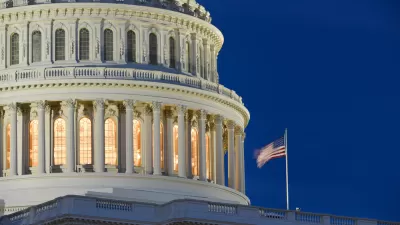The American Recovery and Reinvestment Act (ARRA) was signed into law on February 17, 2009, less than a month into President Obama's first term. The Council of Economic Advisers recently presented its final quarterly report on ARRA's impacts.
Jason Furman writes for WhiteHouse.gov about the accumulated impacts for the 2009 federal stimulus package on the occasion of its five-year anniversary. Here are some of the key findings of the Council of Economic Adviors' final report on the impacts of the $787 billion spending bill:
- “The Recovery Act, by itself, saved or created about 6 million job-years, where a job-year is defined as one full-time job for one year.”
- “[The] Recovery Act improved more than 40,000 miles of road and over 2,700 bridges, brought 693 drinking water systems serving over 48 million Americans into compliance with the Clean Water Act, made high-speed internet available to about 20,000 community institutions, and launched the Race to the Top program, which incentivized 34 states to improve their education policies.”
Furman also includes assessments of the impacts of the additional fiscal and economic measures approved by President Obama, like “a temporary payroll tax cut for 160 million working Americans.”
FULL STORY: The Fifth Anniversary of the American Recovery and Reinvestment Act

Alabama: Trump Terminates Settlements for Black Communities Harmed By Raw Sewage
Trump deemed the landmark civil rights agreement “illegal DEI and environmental justice policy.”

Study: Maui’s Plan to Convert Vacation Rentals to Long-Term Housing Could Cause Nearly $1 Billion Economic Loss
The plan would reduce visitor accommodation by 25% resulting in 1,900 jobs lost.

Why Should We Subsidize Public Transportation?
Many public transit agencies face financial stress due to rising costs, declining fare revenue, and declining subsidies. Transit advocates must provide a strong business case for increasing public transit funding.

Paris Bike Boom Leads to Steep Drop in Air Pollution
The French city’s air quality has improved dramatically in the past 20 years, coinciding with a growth in cycling.

Why Housing Costs More to Build in California Than in Texas
Hard costs like labor and materials combined with ‘soft’ costs such as permitting make building in the San Francisco Bay Area almost three times as costly as in Texas cities.

San Diego County Sees a Rise in Urban Coyotes
San Diego County experiences a rise in urban coyotes, as sightings become prevalent throughout its urban neighbourhoods and surrounding areas.
Urban Design for Planners 1: Software Tools
This six-course series explores essential urban design concepts using open source software and equips planners with the tools they need to participate fully in the urban design process.
Planning for Universal Design
Learn the tools for implementing Universal Design in planning regulations.
Smith Gee Studio
Alamo Area Metropolitan Planning Organization
City of Santa Clarita
Institute for Housing and Urban Development Studies (IHS)
City of Grandview
Harvard GSD Executive Education
Toledo-Lucas County Plan Commissions
Salt Lake City
NYU Wagner Graduate School of Public Service




























